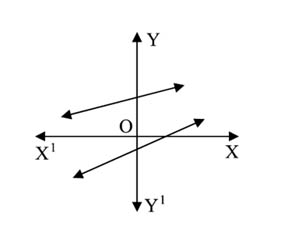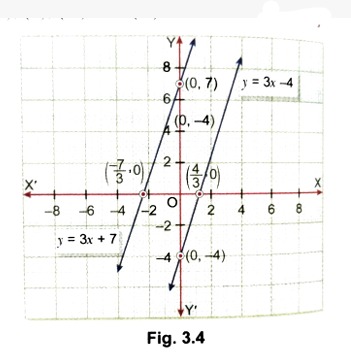Topic Question Set
Q 1
:
The pair of linear equations 2x + 3y = 5 and 4x + 6y = 10 is
inconsistent
consistent
dependent consistent
none of these
(3)
Dependent Consistent
Q 2
:
If the system of equations is inconsistent, then k =
-1
0
1
2
(4)
...(i)
and ...(ii)
Comparing eq. (i) with and eq. (ii)
with we get
and
Since, system is inconsistent, then
Hence, the value of is 2.
Q 3
:
In the given figure, graphs of two linear equations are shown. The pair of these linear equations is:


consistent with unique solution.
consistent with infinitely many solutions.
inconsistent.
inconsistent but can be made consistent by extending these lines.
(4) inconsistent but can be made consistent by extending these lines.
Q 4
:
The pair of equations x = 2a and y = 3b graphically represents straight lines which are :
coincident
parallel
intersecting at (2a, 3b)
intersecting at (3b, 2a)
(3) intersecting at (2a, 3b)
Q 5
:
The value of k for which the system of equations 3x – y + 8 = 0 and 6x – ky + 10 = 0 has infinitely many solutions, is
– 2
2
1/2
− 1/2
(2)
Given equation are and
Here,
For Infinite many solution,
Q 6
:
Consider the equation changes from y = 3x + 7 to y = 3x − 4. What is true about the changes to the graph?
(i) The coefficient of x remains same.
(ii) The value of y at x = 0 decreases.
(iii) Both lines are on the same side of the origin.
(iv) The line shifts downward.

(i) The coefficient of x remains same.
(ii) The value of y at x = 0 decreases.
(iii) Both lines are on the same side of the origin.
(iv) The line shifts downward.

(i), (iii) and (iv)
(ii) and (iv) only
(i), (ii) and (iv)
(i), (ii), (iii) and (iv)
(3)
When the equation changes from y = 3x + 7 to y = 3x − 4, the graph changes as shown in the figure.
(i) Yes, the coefficient of x i.e., 3 remains same.
(ii) The value of y at x = 0 decreases from 7 to −4.
(iii) Clearly, both lines are on the opposite side of the origin.
(iv) Yes, the line shifts downward.
Q 7
:
Consider the lines given by the equations y = (1/3)x + 5 and y = (1/3)x − 2. Which of the following statements are true regarding these lines?
(i) They intersect in 1st quadrant.
(ii) They are parallel to each other.
(iii) They intersect at the point where x = −1.
(iv) They have different values of y at x = 0.
(ii) They are parallel to each other.
(iii) They intersect at the point where x = −1.
(iv) They have different values of y at x = 0.
(i), (iii) and (iv)
(i), (ii), (iii) and (iv)
(ii) and (iv)
(i) and (iv)
(3)
Here, a?/a? = (1/3)/(1/3) = 1, b?/b? = (−1)/(−1) = 1, c?/c? = 5/(−2).
The two lines are parallel (as a?/a? = b?/b? ≠ c?/c?). Therefore, they do not intersect.
At x = 0, y = (1/3)×0 + 5 = 5.
At x = 0, y = (1/3)×0 − 2 = −2.
Hence, statements (ii) and (iv) are correct
Q 8
:
For the equations 2x + y = 8 and 4x + 2y = 10, select the correct statements:
(i) The lines are identical.
(ii) The lines are parallel.
(iii) The second equation can be reduced to 2x + y = 5.
(iv) There is no solution to this system.
(ii) The lines are parallel.
(iii) The second equation can be reduced to 2x + y = 5.
(iv) There is no solution to this system.
(i), (iii) and (iv)
(i), (ii), (iii) and (iv)
(ii), (iii) and (iv)
(i) and (iv)
(3)
We have, 2x + y = 8 …(i)
And, 4x + 2y = 10 ⇒ 2(x + y) = 2×5 ⇒ 2x + y = 5.
Here, a?/a? = 2/2 = 1, b?/b? = 1/1 = 1, c?/c? = 8/5.
Since a?/a? = b?/b? ≠ c?/c?, the lines are parallel. So, there is no point of intersection.
Hence, no solution.
Q 9
:
Given the equations y = −2x + 3 and y = 2x − 1, identify the correct descriptions about their graph and intersection:
(i) The lines intersect in the fourth quadrant.
(ii) The lines intersect in the first quadrant.
(iii) They are parallel lines.
(iv) Area of triangle formed by two lines with y-axis is 2 sq. units.

(ii) The lines intersect in the first quadrant.
(iii) They are parallel lines.
(iv) Area of triangle formed by two lines with y-axis is 2 sq. units.

(i), (iii) and (iv)
(i), (ii), (iii) and (iv)
(ii) and (iii)
(ii) and (iv)
(4)
Solving the system graphically, they intersect at (1, 1) in the first quadrant.
The lines are not parallel.
Area of ΔABC = (1/2) × AB × PC = (1/2) × 4 × 1 = 2 sq. units.
Q 10
:
The pair of equations ax + 2y = 9 and 3x + by = 18 represents parallel lines, where a, b are integers, if:
a = b
3a = 2b
2a = 3b
ab = 6
(4)
Given, ax + 2y = 9 and 3x + by = 18 represent parallel lines.
∴ a?/a? = b?/b? ≠ c?/c? ⇒ a/3 = 2/b ≠ -9/-18
⇒ a/3 = 2/b ⇒ ab = 6

